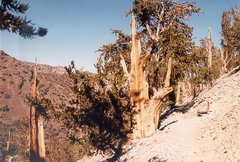Great Basin Bristlecone Pine
|
|
| Great Basin Bristlecone Pine Conservation status: Vulnerable | ||||||||||||||||
|---|---|---|---|---|---|---|---|---|---|---|---|---|---|---|---|---|
 A Great Basin Bristlecone Pine in the White Mountains, California | ||||||||||||||||
| Scientific classification | ||||||||||||||||
|
The Great Basin Bristlecone Pine (Pinus longaeva) is one of the bristlecone pines, a group of three species of pine found in the higher mountains of the southwest United States. Great Basin Bristlecone Pine occurs in Utah, Nevada and eastern California. In California, it is restricted to the White Mountains, the Inyo Mountains, and the Panamint Range, in Mono and Inyo counties. In Nevada, it is found in most of the higher ranges of the Basin and Range from the Spring Mountains near Las Vegas north to the Ruby Mountains, and in Utah, northeast to South Tent in the Wasatch Range.
It is a medium-size tree, reaching 5-15 m tall and with a trunk diameter of up to 2.5 m, exceptionally 3.6 m diameter. The bark is bright orange-yellow, thin and scaly at the base of the trunk. The leaves ('needles') are in fascicles of five, stout, 2.5-4 cm long, deep green to blue-green on the outer face, with stomata confined to a bright white band on the inner surfaces. The cones are ovoid-cylindrical, 5-10 cm long and 3-4 cm broad when closed, green or purple at first, ripening orange-buff when 16 months old, with numerous thin, fragile scales, each scale with a bristle-like spine 2-5 mm long. The cones open to 4-6 cm broad when mature, releasing the seeds immediately after opening. The seeds are 5 mm long, with a 12-22 mm wing; they are mostly dispersed by the wind, but some are also dispersed by Clark's Nutcrackers, which pluck the seeds out of the opening cones. The nutcrackers uses the seeds as a food resource, storing many for later use, and some of these stored seeds are not used and are able to grow into new plants.
It differs from the Rocky Mountains Bristlecone Pine in that the needles always have two resin canals, and these are not interrupted and broken, so it lacks the characteristic small white resin flecks appearing on the needles in that species. From the Foxtail Pine, it differs in the cone bristles being over 2 mm long, and the cones having a more rounded (not conic) base.
The oldest known tree in the world is a specimen of this species located in the White Mountains, with an age of 4,700 years, measured by annual ring count on a small core taken with an increment borer. It bears the nickname "Methuselah".
External link
- Photo of cone (scroll to bottom of page) (http://www.pinetum.org/cones/PNDucampopinus.htm)
